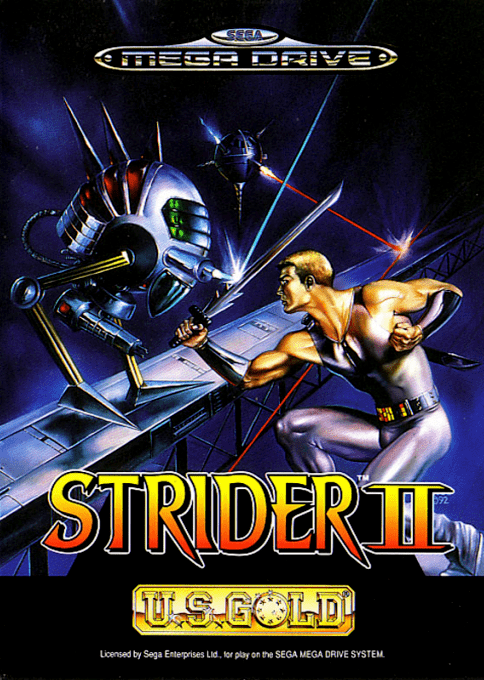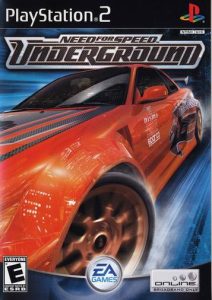Strider
Strider, released in Japan as Strider Hiryū,[b] is a hack-and-slash platform game released in arcades in 1989 by Capcom. Strider is set in a dystopian future with a wide range of settings that affect gameplay. The game resulted from cooperation between Capcom and manga publisher Moto Kikaku. It marked the video game debut of Strider Hiryu, after the character was introduced in the 1988 manga Strider Hiryu.
The game debuted on Capcom’s CP System arcade board. Various home computer ports were developed by Tiertex and published by U.S. Gold in 1989. The NES version has a different plot than the original. Sega released Strider for its own Genesis console in 1990. Of all home versions, the Genesis adaptation is considered the most successful, winning the Game of the Year and Best Graphics in a Video Game awards from Electronic Gaming Monthly in 1990.
Strider‘s gameplay is cited as a major influence on the video game franchises Ninja Gaiden, Devil May Cry, and God of War. It became one of Capcom’s early hits, praised for its innovative gameplay, diverse and unique music, and multilingual voice samples.
Gameplay – Strider

The controls of Strider consist of an eight-way joystick and two action buttons for attacking and jumping. The player controls the protagonist Strider Hiryu, a ninja whose main weapon is a tonfa-like plasma sword known as a “Cypher”. He can perform numerous acrobatic feats depending on the joystick/button combination used. Pressing the jump button while Hiryu is standing still will cause him to do a regular vertical jump, while pressing the jump button while pushing the joystick left or right will enable him to do a cartwheel jump. Hiryu can also slide under or through certain obstacles and enemies by first crouching down and then pressing the jump button.
As well as his sliding move, both jumps can also be used to destroy weaker opponents. Hiryu is able to latch onto certain platforms, and climb across walls and ceilings using a metallic hook. While running down a sloped surface, Hiryu can gain enough momentum to allow him to do a longer cartwheel jump than usual.
Numerous power-ups can be obtained from item boxes carried by certain enemies. These include an extension to Hiryu’s attack range that lasts for one hundred slashes, two types of health aids (represented by the kanji used to write Hiryu’s name: 飛 and 飛竜), a max health extension (represented by the kanji 竜, the second character in Hiryu’s name), an extra life, and a power-up that not only makes Hiryu invulnerable to attack but also increases his own attack abilities via shadow images of himself for 15 seconds.[13] Hiryu can also summon robotic companions known collectively as “options” that help him fight enemies. These consist of up to two mushroom-like droids, a saber-toothed robo tiger and a robot hawk, known individually as Options A, B and C respectively.[14]
The game has five stages: the Kazakh Soviet Socialist Republic (called “St. Petersburg” during the arcade game’s attract sequence), the Siberian Wilderness, the Aerial Battleship Balrog, the Amazonian Jungle, and the Grandmaster’s lair itself, the Third Moon. Each of the stages is divided into a number of smaller sections, each with their own time limit and checkpoint location. The player has a three-point health gauge (which can be increased to five points with the health extensions). Hiryu will lose a life when either his health gauge is fully depleted, by moving him off the screen entirely (like falling into a bottomless pit) or when the game’s timer reaches zero. It is Game Over when all of Hiryu’s lives are lost, but the player can be given the opportunity to continue.
Plot – Strider
| This article needs an improved plot summary. You can provide one by editing this article. (April 2015) (Learn how and when to remove this template message) |
Strider is set in a dystopian future in the year 2048, where a mysterious dictator known as the “Grandmaster” rules over the world. Hiryu, the youngest ever Super A Ranked[15] member of an organization of high-tech ninja agents known as the “Striders”, is alone tasked with the Grandmaster’s assassination. Hiryu begins his mission by infiltrating the Grandmaster’s capital at the Kazakh Soviet Socialist Republic, a Federation referred to as Eastern European which became the Imperial Capital of the Russian Empire by the year 2048.[16] The game features multilingual voice clips during cutscenes (presented in English, Japanese, Mandarin, Spanish, Russian and Swahili).
Development – Strider
The arcade version of Strider was part of a three-way project conceived in a collaboration between Capcom and Hiroshi Motomiya’s manga studio Moto Kikaku, which also included the Strider Hiryu manga by Moto Kikaku’s Tatsumi Wada that was published in Kodansha‘s Comic Computique anthology in Japan, as well as the NES version of Strider. Kouichi Yotsui, director of the coin-op Strider (who is credited as Isuke in the game), was chosen for his experience with the CP System hardware while working as a background designer on Ghouls ‘n Ghosts. The three projects were developed independently of each other.[17]
According to Yotsui the franchise was conceived as a multimedia collaboration between video game company Capcom and manga collective Moto Kikaku, the two companies having previously collaborated on the video game versions of the manga Tenchi wo Kurau. Moto Kikaku produced the manga version, while Capcom developed two separate video game versions, a coin-operated video game and a console version for the NES. All three works share common plot elements, while featuring their differences as well.[17] He further said it was he who “pushed for a ninja concept” as they were leaning towards an action game, a ninja setting would’ve been convenient. “The hero would be derived from a ninja. We loosely decided on that.”[18
] Regarding Hiryu’s three robot helpers, he said that he was inspired by the 1960s ninja comics (the one that most influenced him was Shirato Sanpei‘s Kamui Gaiden), in which the ninja often had various animals to support them or attack their enemies.[18] Speaking with Retro Gamer, Yotsui said that Strider Hiryu’s climbing abilities were inspired by his personal experience when he got himself stranded on the roof of Capcom’s building; fearing freezing to death and with no way to call for help, he climbed down the side of the building to reach a nearby fire escape stairway.[19]
The original arcade game soundtrack was composed entirely by female video game music composer Junko Tamiya, who was not credited for her work in the arcade version but was mentioned as part of the original arcade staff in some console adaptations. Early revisions of the arcade game were missing the unique music for the Aerial Battleship and Third Moon stages. In this version the music from the first stage of the game was repeated here instead.[10]
Strider contains many different styles of themes that change dynamically throughout the game according to the stages and the situations on screen. These range from experimental and progressive futuristic sci-fi action themes to baroque, tribal and classical music pieces. Elements from the soundtrack have also been used in other Capcom games where Hiryu has appeared. These include the Marvel vs. Capcom series as well as other Strider related games.[10]
Ports – Strider
Ports of Strider for the Amiga, Amstrad CPC, Atari ST, Commodore 64, IBM PC compatibles, and ZX Spectrum were published by U.S. Gold and developed by Tiertex in 1989. The U.S. Gold versions have the order of the third and fourth stages swapped (the order of the cut-scenes were kept the same, causing a continuity error), and the final battle with the Grandmaster missing (the last stages end with the battle against the giant robot gorilla Mecha Pong). As a result, the ending was changed to reveal that the events of the game were a simulation that the player was going through. All five versions featured downgraded graphics, less music and missing enemies compared to the arcade version. Additionally, the controls were modified so that the game would be compatible with one-button joystick controllers
Despite these changes, all of the U.S. Gold releases received high review scores by computer game magazines of the time. Later, in 1992, the assets of the Amiga versions were used for the conversion on the Master System, also made by Tiertex. A final fight with the Grandmaster was added in this version, but the ending credits continue to say that all was just a simulation.
Sega produced their home version of Strider for the Mega Drive/Genesis, which was released in Japan on September 29, 1990, with subsequent releases in North America and the PAL region. It was advertised as one of the first 8-Megabit cartridges for the system, and went on to be a bestseller.[20] This version was also re-released for the Wii Virtual Console in Japan on November 15, 2011 and in North America on February 16, 2012. It was re-released again on the Nintendo Switch Online + Expansion Pack service on October 25, 2021.[21] The Genesis/Mega Drive version contains a different ending from the arcade game. This ending shows the destruction of the final stage as the game’s protagonist makes his escape.
This is then followed by the main credit sequence that sees Hiryu flying his glider in space and reminiscing about the various encounters he had during his mission as he heads back to earth. The ending theme was an edited combination of two separate pieces of music planned for the arcade game, but replaced with a repeat of the first level music.[22] Computer magazine ACE considered the previous Amiga conversion to be “as good as this one”.[23]
Capcom separately produced a version for the Sharp X68000 computer in 1991, releasing it exclusively in Japan. It is a very close reproduction of the arcade original, with minimal changes.
A version for the Capcom Power System Changer was planned and previewed but never released.[24]
NEC Avenue produced a PC Engine CD version of Strider Hiryu, which was released exclusively in Japan on September 22, 1994 as a CD-ROM² title which requires the Arcade Card expansion. It features an all-new desert stage that was not in the arcade version, as well as newly recorded cut-scenes, music and dialogue, with Japanese voice actor Kaneto Shiozawa as the voice of Hiryu and Kōji Totani as the Grand Master. The PC Engine CD version had a long development process, having been planned in various formats, including the SuperGrafx at one point.[25]
The PlayStation version of Strider was first released by Capcom in 2000 as a second disc which came packaged with the PlayStation version of Strider 2. The North American release has the Strider and Strider 2 game code pressed onto the wrong disc. This version was reissued separately in Japan on October 24, 2006 as part of the Capcom Game Books series, which included an extended manual and strategy guide for the game.[26] This makes this standalone version technically the last original PlayStation game ever made, released after the system’s discontinuation in March 2006.
The original arcade version was included in the 2006 video game compilations Capcom Classics Collection: Remixed for the PlayStation Portable and Capcom Classics Collection Vol. 2 for the PlayStation 2 and Xbox. A Japanese mobile phone version was released in 2010.[27]
 (Virtual Console)-1024x656.png)
Uroboros – The Iron Ruler
Capture!
Driving Wheel
Introduction 4
Mosque the Cold-Hearted











